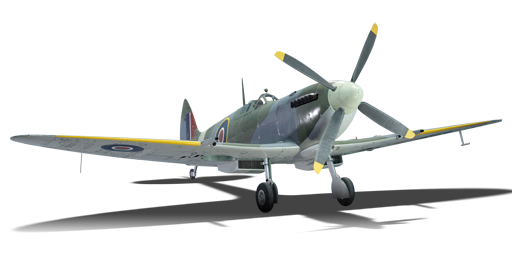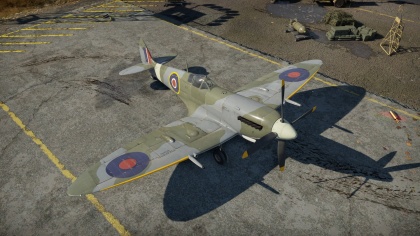Difference between revisions of "Spitfire LF Mk IX"
m (→Pros and cons) (Tag: Visual edit) |
(→Details) (Tag: Visual edit) |
||
| Line 58: | Line 58: | ||
! Combat !! Take-off !! Landing !! + !! - | ! Combat !! Take-off !! Landing !! + !! - | ||
|- | |- | ||
| − | | {{Specs|destruction| | + | |{{Specs|destruction|body}} |
| + | |{{Specs|destruction|gear}} | ||
| + | | N/A || N/A || 230 || ~10 || ~4 | ||
|- | |- | ||
|} | |} | ||
Revision as of 20:38, 19 July 2020
Contents
| This page is about the British fighter Spitfire LF Mk IX. For other versions, see Spitfire (Family). |
Description
The Spitfire LF Mk IX is a rank British fighter
with a battle rating of (AB), (RB), and (SB). It was introduced in Update 1.35.
The Spitfire LF Mk IX is very much a short range, point interceptor fighter and the stand out fighter in the mid Spitfire line-up. It features an exceptional rate of climb, whilst still retaining the manoeuvrability of its early lineage. The LF Mk IX is considered by most to be the perfect Spitfire due to its balanced all round performance and impressive statistics. The last of the Merlin-engined Spitfires before progressing on to the Griffon powered variants, it has the perfect balance of turning performance (second only to its Japanese counterparts) as well as its "Boom and Zoom" capability that becomes more possible with later model Spitfires.
General info
Flight performance
Describe how the aircraft behaves in the air. Speed, manoeuvrability, acceleration and allowable loads - these are the most important characteristics of the vehicle.
| Characteristics | Max Speed (km/h at 4,878 m) |
Max altitude (metres) |
Turn time (seconds) |
Rate of climb (metres/second) |
Take-off run (metres) | |||
|---|---|---|---|---|---|---|---|---|
| AB | RB | AB | RB | AB | RB | |||
| Stock | 631 | 612 | 16.4 | 17.0 | 22.2 | 320 | ||
| Upgraded | 724 | 688 | 15.1 | 14.8 | 48.4 | 31.8 | ||
Details
| Features | ||||
|---|---|---|---|---|
| Combat flaps | Take-off flaps | Landing flaps | Air brakes | Arrestor gear |
| X | X | ✓ | X | X |
| Limits | ||||||
|---|---|---|---|---|---|---|
| Wings (km/h) | Gear (km/h) | Flaps (km/h) | Max Static G | |||
| Combat | Take-off | Landing | + | - | ||
| N/A | N/A | 230 | ~10 | ~4 | ||
| Optimal velocities (km/h) | |||
|---|---|---|---|
| Ailerons | Rudder | Elevators | Radiator |
| < 321 | < 400 | < 350 | > 470 |
| Compressor | Optimal altitude | 100% Engine power | WEP Engine power |
|---|---|---|---|
| Setting 1 | 3,600 m | 1,440 hp | 1,843 hp |
| Setting 2 | 6,800 m | 1,340 hp | 1,664 hp |
Survivability and armour
- 38 mm Bulletproof glass in the cockpit front.
- 4 mm Steel plate in the pilot's seat.
- 6-7 mm Steel plates behind the pilot.
- 3 mm Steel plate on top of the fuel tanks.
- 3 mm Steel boxes around the wing ammunition.
Armaments
Offensive armament
The Spitfire LF Mk IX is armed with:
- 2 x 20 mm Hispano Mk.II cannons, wing-mounted (135 rpg = 270 total)
- 2 x 12.7 mm M2 Browning machine guns, wing-mounted (260 rpg = 520 total)
Suspended armament
The Spitfire LF Mk IX can be outfitted with the following ordnance:
- Without load
- 1 x 250 lb G.P. Mk.IV bomb (250 lb total)
Usage in battles
Describe the tactics of playing in the aircraft, the features of using aircraft in a team and advice on tactics. Refrain from creating a "guide" - do not impose a single point of view, but instead, give the reader food for thought. Examine the most dangerous enemies and give recommendations on fighting them. If necessary, note the specifics of the game in different modes (AB, RB, SB).
Manual Engine Control
As with all the other British planes, this plane is also very forgiving when using Manual Engine Settings.
Prop pitch: This should be set to 100% when climbing to utilize the aircraft's superior climb rate. This will come in handy both at the start of a match and during combat. However when in level flight or chasing another plane this can be set back as far to 70-80% to get a few more km/h.
Radiator: as soon as you unlock the radiator module you can set this to 30% and leave it there for the entire match. On Sicily however you want to set it to 35-40% until you reach 6,000 m (19,685 ft)
Supercharger: Switching this at 2,000 m (6,561 ft) will give you quite a boost in performance and it will retain its climbrate up until 4,500 m, after it will suffer miserably but still climb better than almost every plane. Therefore the supercharger gears should be switched at 2 km (6,561 ft) altitude
| MEC elements | ||||||
|---|---|---|---|---|---|---|
| Mixer | Pitch | Radiator | Supercharger | Turbocharger | ||
| Oil | Water | Type | ||||
| Controllable | Controllable Auto control available |
Not controllable Not auto controlled |
Controllable Auto control available |
Combined | Controllable 2 gears |
Not controllable |
Modules
| Tier | Flight performance | Survivability | Weaponry | ||
|---|---|---|---|---|---|
| I | Fuselage repair | Radiator | Offensive 12 mm | Offensive 20 mm | |
| II | Compressor | Airframe | New 12 mm MGs | New 20 mm cannons | |
| III | Wings repair | Engine | SBC mark 25 | Mk.II year 1942 | |
| IV | 150 octane fuel | Engine injection | Cover | Mk.II year 1943 | |
Pros and cons
Pros:
- Supreme rate of climb that will rival that of the later Griffon Spitfires and most late war props (46.7 m/s in AB, 31.8m/s in RB/SB when maxed out, beating the F8F-1B at altitudes below 7 km)
- Excellent acceleration from a standing start due to the boost configuration
- Exceptional manoeuvrability at all altitudes
- Good energy retention - Better than the Bf 109 K-4 and the Ta 152 H-1
- M2 Browning .50 cal machine guns are more powerful than the old .303 Brownings
- Has access to 150 Octane Fuel will increase your engine power by a large margin
Cons:
- Tendency to break wings its during high speed manoeuvres
- Sub average roll rate can make the plane suffer in tight scissors
- Limited dive rate, moderate parasitic drag
- Limited ammo capacity
- Due to high wing loading, even slight damage to the wings can impact performance negatively
- Poor top speed due to high parasitic drag compared to engine power
- Since it is an 'LF (low-altitude fighter)' Spitfire, this Spitfire's performance suffers at high altitude
History
Describe the history of the creation and combat usage of the aircraft in more detail than in the introduction. If the historical reference turns out to be too long, take it to a separate article, taking a link to the article about the vehicle and adding a block "/History" (example: https://wiki.warthunder.com/(Vehicle-name)/History) and add a link to it here using the main template. Be sure to reference text and sources by using <ref></ref>, as well as adding them at the end of the article with <references />. This section may also include the vehicle's dev blog entry (if applicable) and the in-game encyclopedia description (under === In-game description ===, also if applicable).
In-game description
The Supermarine Spitfire was a British single-engine, all-metal, low-wing monoplane fighter. While the Mk VII and Mk VIII variants was being designed, a Spitfire Mk III was tested in September 1941 with the new Rolls Royce 60 in the hopes of developing an interim fighter to use as a stop gap measure. The new Spitfire performed exceptionally well, and was rushed into production as the Mk IX. The Air Fighting Development Unit described the Mk IX as ‘outstandingly better than the Mk V especially at heights above 20,000 feet’ and even though it was not fitted with the modified control surfaces under development for the Mk VII and Mk VIII, the Mk IX was more than capable of meeting the Focke-Wulf FW190 on favourable terms. The Mk IX was fitted with the Type C ‘universal’ wing and originally carried the tried and tested combination of two 20mm cannon and four 0.303 inch machine guns, but in later versions the four 0.303 machine guns were replaced with two .50 calibre guns.
A total of 5,665 Mk IX were produced and 262 more Mk Vs were converted to Mk IX. Intended as a transitional stop-gap measure for the Mk VII and Mk VIII, the variant remained in production until the end of the war, ultimately becoming the most mass-produced Spitfire version. This mark was also used as a fighter-bomber and as a reconnaissance aircraft. Further modifications were incorporated into the Mk IX throughout its service life, such as a gyroscopic gunsight, bubble canopy and modified engine intercooler. Widely considered to be the most capable fighter in the world at the time of its introduction, it would take the introduction of the Rolls Royce Griffon engine to push the Spitfire into its next stage of evolution.
Media
See also
Links to the articles on the War Thunder Wiki that you think will be useful for the reader, for example:
- reference to the series of the aircraft;
- links to approximate analogues of other nations and research trees.
External links
Paste links to sources and external resources, such as:
- topic on the official game forum;
- encyclopedia page on the aircraft;
- other literature.
| Supermarine | |
|---|---|
| Spitfires | |
| Merlin engine | Spitfire Mk Ia · Spitfire Mk IIa · Spitfire Mk.IIa Venture I · Spitfire Mk IIb |
| Spitfire Mk Vb · Spitfire Mk Vb/trop · Spitfire Mk Vc · Spitfire Mk Vc/trop | |
| Spitfire F Mk IX · Spitfire F Mk IXc · Spitfire F Mk XVI | |
| Spitfire LF Mk IX · Plagis' Spitfire LF Mk IXc | |
| Griffon engine | Spitfire F Mk XIVc · Spitfire F Mk XIVe · Prendergast's Spitfire FR Mk XIVe · Spitfire F Mk XVIIIe · Spitfire F Mk 22 · Spitfire F Mk 24 |
| Export | ▄Spitfire Mk Vb/trop · ▃Spitfire LF Mk IXc · ▂Spitfire Mk IXc · Spitfire Mk IXc · Spitfire Mk.IX (CW) · Weizman's Spitfire LF Mk.IXe · ▄Spitfire FR Mk XIVe |
| Seafires | Seafire LF Mk.III · Seafire F Mk XVII · Seafire FR 47 |
| Export | ▄Seafire LF Mk.III |
| Jet fighters | Attacker FB 1 · Attacker FB.2 · Scimitar F Mk.1 · Swift F.1 · Swift F.7 |
| Hydroplanes | Walrus Mk.I |





